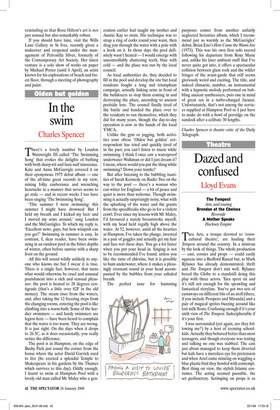Generosity of spirit
Andrew Lambirth
Rose Hilton: A Selected Retrospective Tate St Ives, until 11 May
Rose Hilton was born Rosemary Phipps in the Kentish village of Leigh, near Tonbridge, in 1931. She grew up the dutiful daughter of parents who were strict Plymouth Brethren, but early on she showed distinct signs of artistic talent. Her parents considered that this might equip her as an art teacher, but Rose had higher ambitions: she determined to be a painter. Force of character combined with innate skills took her from Beckenham Art School to the Royal College of Art in London, where she won prizes and was praised by her tutor Carel Weight for her sense of colour. She looked all set for a successful career in art until she met that uncompromising painter Roger Hilton, 20 years her senior, a man who many thought was ‘mad, bad and dangerous to know’. Rose found him irresistible, and stayed with him from 1960 until his premature death in 1975, putting her own career on hold to look after him and care for their children. This fascinating exhibition traces her work from the early years of promise to her mature vision, which only really blossomed after Roger’s death.
I must at once declare an interest: I have not only written the catalogue essay for this show, but am also embarking upon a book on Rose Hilton’s life and work. I first met Rose when I had written an essay about Roger Hilton’s drawings in 2001, a commission which led in due course to my writing an extensive monograph on Roger, published last year by Thames & Hudson. During the course of the research for that book I got to know Rose quite well and realised that there was very definitely another side of the Hilton story to Roger’s, and one that was worth telling. Meanwhile, the more I saw of Rose’s own painting, the more I enjoyed and admired it, writing at length about it for the first time in 2004. Rose’s strengths as a painter are very different from Roger’s, for the guiding temperament behind her work is gentle compared with Roger’s confrontational approach. But her art is none the less valid for wanting to celebrate the glory in everyday life, rather than knock it down and rebuild it as Roger did.
The years with Roger (which she calls ‘being at the heart of the matter with a master painter’) did however teach Rose a great deal about painting and about what she herself wanted to achieve. She may have painted little in that time but she absorbed and learnt a lot. (Two precepts of Roger’s she still quotes: when you put down one colour, what you put next to it is of the utmost importance. And, when you change the colour, you must change the tone.) There are those critics who think that Rose’s best work is closest to Roger’s, rather than the paintings done in the softer Wilson Steerlike impressionism that she also espouses. Looking at the range of work in this selective retrospective which covers more than half a century (1950–2007), I am struck anew by its variety, freshness and pre-eminent generosity of spirit.
Rose paints the figure primarily, but also still-life and landscape. She depicts the female nude with a marvellously compelling languor and sensuality, a candour that hints at civilised bohemia, but also points to something deeper, a radiant serenity that seems to reaffirm all that is good in man. From the early Giacometti influence of ‘Interior, Beckenham Art School’ (1951), in subtle dove greys and leaf browns, to the Ecole de Paris colourism of her more recent nudes, Rose runs the gamut of mood and emotion. She often mingles interior with exterior in a typically Matissean way by including a view through a window, and seems to employ two distinct palettes — an austere winter one and a more vivid Mediterranean one for summer. She works from observation out in the landscape or with a model in the studio, but also relies on memory and imagination to help build her pictures. Among the impressive array of paintings here are at least two masterpieces: ‘Locked in Love’ (1970), a thrillingly tender celebration of intimacy, and ‘Winter Botallack’ (1999), a tough but lyrical evocation of the energies of the Cornish landscape.
A separate display consists of paintings selected by Rose Hilton from the Tate Collection, works that have particularly inspired or influenced her. Inevitably there is Roger, along with the chromatic luminosities of Matisse and Bonnard to add weight to the argument for building a picture with colour (and not minding whether anyone calls you ‘decorative’). Then there is a host of other English artists, including those who actually taught Rose like Cecil Collins, and those who inspired her like Ivon Hitchens, Adrian Stokes and Mary Potter. Interestingly, the Cornish contingent are not widely represented here and, although Ben Nicholson is present, so is his first wife Winifred, rather than his second, Barbara Hepworth. Two important figures whose inclusion might cause surprise are Henry Moore and David Bomberg, reminding us that Rose Hilton’s art is not just sensual but also remarkably robust.
If you should have time, visit the Wills Lane Gallery in St Ives, recently given a makeover and reopened under the management of Petronilla Silver, formerly of the Contemporary Art Society. Her latest venture is a solo show of works on paper by Michael Porter (until 6 April), an artist known for his explorations of beach and forest floor, through a meeting of photography and paint.











































































 Previous page
Previous page